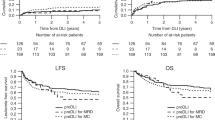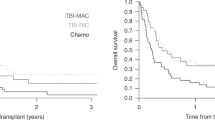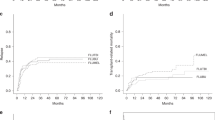Abstract
Allogeneic stem cell transplantation (SCT) using reduced-intensity conditioning (RIC) has potential to be a promising treatment of aggressive chronic lymphocytic leukemia (CLL). Since available clinical data obtained with this novel approach are very limited, we have performed a survey on this issue. Data of 77 patients were collected from 29 European Group for Blood and Marrow Transplantation centers. Median age was 54 (30–66) years, and the median number of previous chemotherapy regimens was 3 (0–8). HLA-identical sibling donors were used in 81% of the cases. Moderate conditioning regimens (mainly low-dose total body irradiation (TBI) or fludarabine–cyclophosphamide combinations) were administered to 56% of the patients, whereas the remainder received more intense conditioning consisting of fludarabine–busulfan or high-dose melphalan combinations. In 40% of the patients, in vivo T-cell depletion (TCD) with anti-thymocyte globulin or CAMPATH-1H was part of the conditioning regimen. Cumulative treatment-related mortality (TRM) was 18% (95% CI 9; 27) after 12 months. Complete chimerism as well as best response was not achieved immediately post-transplant but took a median of 3 months to develop. The 2-year probability of relapse was 31% (95% CI 18; 44), with no event occurring later than 12 months post transplant in the absence of TCD. With one exception, relapses were not observed after onset of chronic graft-versus-host disease. Event-free and overall survival at 24 months were 56% (95% CI 43; 69) and 72% (95% CI 61; 83), respectively. The median follow-up was 18 (1–44) months. Donor lymphocyte infusions or secondary transplants were performed in 19 patients with insufficient disease control and/or incomplete donor chimerism post-transplant, leading to a response in seven patients (37%). Preliminary multivariate analysis identified less than PR at transplant (hazard ratio (HR) 3.5; P<0.01) and alternative donor (HR 3.1; P=0.02) as significant risk factors for relapse, whereas number of previous regimens >2 (HR 5.4; P=0.03), TBI (HR 2.5; P=0.05), and alternative donor (HR 2.3; P=0.08) were risk factors for survival. We conclude that RIC might favorably influence the outcome after allogeneic SCT for CLL by reducing TRM while preserving graft-versus leukemia activity.
This is a preview of subscription content, access via your institution
Access options
Subscribe to this journal
Receive 12 print issues and online access
$259.00 per year
only $21.58 per issue
Buy this article
- Purchase on Springer Link
- Instant access to full article PDF
Prices may be subject to local taxes which are calculated during checkout




Similar content being viewed by others
References
Rozman C, Montserrat E . Chronic lymphocytic leukemia. N Engl J Med 1995; 333: 1052–1057.
Döhner H, Stilgenbauer S, Döhner K, Bentz M, Lichter P . Chromosome aberrations in B-cell chronic lymphocytic leukemia: reassessment based on molecular cytogenetic analysis. J Mol Med 1999; 77: 266–281.
Mauro FR, Foa R, Giannarelli D, Cordone I, Crescenzi S, Pescarmona E et al. Clinical characteristics and outcome of young chronic lymphocytic leukemia patients: a single institution study of 204 cases. Blood 1999; 94: 448–454.
Damle RN, Wasil T, Fais F, Ghiotto F, Valetto A, Allen SL et al. Ig V gene mutation status and CD38 expression as novel prognostic indicators in chronic lymphocytic leukemia. Blood 1999; 94: 1840–1847.
Hamblin TJ, Davis Z, Gardiner A, Oscier DG, Stevenson FK . Unmutated Ig VH genes are associated with a more aggressive form of chronic lymphocytic leukemia. Blood 1999; 94: 1848–1854.
Dreger P, Montserrat E . Autologous and allogeneic stem cell transplantation for chronic lymphocytic leukemia. Leukemia 2002; 16: 985–992.
Michallet M, Archimbaud E, Rowlings PA, Bandini G, Horowitz MM, Bortin MM et al. HLA-identical sibling bone marrow transplants for chronic lymphocytic leukemia. Ann Intern Med 1996; 124: 311–315.
Pavletic ZS, Arrowsmith ER, Bierman PJ, Goodman SA, Vose JM, Tarantolo SR et al. Outcome of allogeneic stem cell transplantation for B cell chronic lymphocytic leukemia. Bone Marrow Transplant 2000; 25: 717–722.
Khouri I, Przepiorka D, van BK, O'Brien S, Palmer JL, Lerner S et al. Allogeneic blood or marrow transplantation for chronic lymphocytic leukaemia: timing of transplantation and potential effect of fludarabine on acute graft-versus-host disease. Br J Haematol 1997; 9: 466–473.
Doney KC, Chauncey T, Appelbaum FR . Allogeneic related donor hematopoietic stem cell transplantation for treatment of chronic lymphocytic leukemia. Bone Marrow Transplant 2002; 29: 817–823.
Toze CL, Shepherd JD, Connors JM, Voss NJ, Gascoyne RD, Hogge DE et al. Allogeneic bone marrow transplantation for low-grade lymphoma and chronic lymphocytic leukemia. Bone Marrow Transplant 2000; 25: 605–612.
Childs R, Clave E, Contentin N, Jayasekera D, Hensel N, Leitman S et al. Engraftment kinetics after nonmyeloablative allogeneic peripheral blood stem cell transplantation: full donor T-cell chimerism precedes alloimmune responses. Blood 1999; 94: 3234–3241.
McSweeney PA, Niederwieser D, Shizuru JA, Sandmaier BM, Molina AJ, Maloney DG et al. Hematopoietic cell transplantation in older patients with hematologic malignancies: replacing high-dose cytotoxic therapy with graft-versus-tumor effects. Blood 2001; 97: 3390–3400.
Cheson BD, Bennett JM, Grever M, Kay N, Keating MJ, O'Brien S et al. National Cancer Institute-sponsored working group guidelines for chronic lymphocytic leukemia: revised guidelines for diagnosis and treatment. Blood 1996; 87: 4990–4997.
Mehta J, Powles R, Singhal S, Iveson T, Treleaven J, Catovsky D . Clinical and hematologic response of chronic lymphocytic and prolymphocytic leukemia persisting after allogeneic bone marrow transplantation with the onset of acute graft-versus-host disease: possible role of graft-versus-leukemia. Bone Marrow Transplant 1996; 17: 371–375.
Rondon G, Giralt S, Huh Y, Khouri I, Andersson B, Andreeff M et al. Graft-versus-leukemia effect after allogeneic bone marrow transplantation for chronic lymphocytic leukemia. Bone Marrow Transplant 1996; 18: 669–672.
Mackinnon S . Who may benefit from donor leucocyte infusions after allogeneic stem cell transplantation? Br J Haematol 2000; 110: 12–17.
Mattsson J, Uzunel M, Remberger M, Ljungman P, Kimby E, Ringden O et al. Minimal residual disease is common after allogeneic stem cell transplantation in patients with B cell chronic lymphocytic leukemia and may be controlled by graft-versus-host disease. Leukemia 2000; 14: 247–254.
Esteve J, Villamor N, Colomer D, Cervantes F, Campo E, Carreras E et al. Stem cell transplantation for chronic lymphocytic leukemia: different outcome after autologous and allogeneic transplantation and correlation with minimal residual disease status. Leukemia 2001; 15: 445–451.
Martino R, Caballero MD, Canals C, Simon JA, Solano C, Urbano-Ispizua A et al. Allogeneic peripheral blood stem cell transplantation with reduced-intensity conditioning: results of a prospective multicentre study. Br J Haematol 2001; 115: 653–659.
Corradini P, Tarella C, Olivieri A, Gianni AM, Voena C, Zallio F et al. Reduced-intensity conditioning followed by allografting of hematopoietic cells can produce clinical and molecular remissions in patients with poor-risk hematologic malignancies. Blood 2002; 99: 75–82.
Perez-Simon JA, Kottaridis PD, Martino R, Craddock C, Caballero D, Chopra R et al. Nonmyeloablative transplantation with or without alemtuzumab: comparison between 2 prospective studies in patients with lymphoproliferative disorders. Blood 2002; 100: 3121–3127.
Khouri IF, Keating M, Korbling M, Przepiorka D, Anderlini P, O'Brien S et al. Transplant-lite: induction of graft-versus-malignancy using fludarabine-based nonablative chemotherapy and allogeneic blood progenitor-cell transplantation as treatment for lymphoid malignancies. J Clin Oncol 1998; 16: 2817–2824.
Slavin S, Nagler A, Naparstek E, Kapelushnik Y, Aker M, Cividalli G et al. Nonmyeloablative stem cell transplantation and cell therapy as an alternative to conventional bone marrow transplantation with lethal cytoreduction for the treatment of malignant and nonmalignant hematologic diseases. Blood 1998; 91: 756–763.
Kottaridis PD, Milligan DW, Chopra R, Chakraverty RK, Chakrabarti S, Robinson S et al. In vivo CAMPATH-1H prevents graft-versus-host disease following nonmyeloablative stem cell transplantation. Blood 2000; 96: 2419–2425.
Cull GM, Haynes AP, Byrne JL, Carter GI, Miflin G, Rebello P et al. Preliminary experience of allogeneic stem cell transplantation for lymphoproliferative disorders using BEAM-CAMPATH conditioning: an effective regimen with low procedure-related toxicity. Br J Haematol 2000; 108: 754–760.
Hamblin TJ, Orchard JA, Ibbotson RE, Davis Z, Thomas PW, Stevenson FK et al. CD38 expression and immunoglobulin variable region mutations are independent prognostic variables in chronic lymphocytic leukemia, but CD38 expression may vary during the course of the disease. Blood 2002; 99: 1023–1029.
Ritgen M, Lange A, Stilgenbauer S, Döhner H, Bretscher C, Bosse H et al. Unmutated immunoglobulin variable heavy chain gene status remains an adverse prognostic factor after autologous stem cell transplantation for chronic lymphocytic leukemia. Blood 2003; 101: 2049–2053.
Acknowledgements
We thank Rosi Schiefelbein for excellent secretary assistance. Supported by the Deutsche José Carreras Leukämie-Stiftung (Grants DJCLS-R16).
Author information
Authors and Affiliations
Consortia
Rights and permissions
About this article
Cite this article
Dreger, P., Brand, R., Hansz, J. et al. Treatment-related mortality and graft-versus-leukemia activity after allogeneic stem cell transplantation for chronic lymphocytic leukemia using intensity-reduced conditioning. Leukemia 17, 841–848 (2003). https://doi.org/10.1038/sj.leu.2402905
Received:
Accepted:
Published:
Issue Date:
DOI: https://doi.org/10.1038/sj.leu.2402905
Keywords
This article is cited by
-
Ibrutinib for bridging to allogeneic hematopoietic cell transplantation in patients with chronic lymphocytic leukemia or mantle cell lymphoma: a study by the EBMT Chronic Malignancies and Lymphoma Working Parties
Bone Marrow Transplantation (2019)
-
Efficacy of cisplatin-based immunochemotherapy plus alloSCT in high-risk chronic lymphocytic leukemia: final results of a prospective multicenter phase 2 HOVON study
Bone Marrow Transplantation (2016)
-
Indications and outcomes of reduced-toxicity hematopoietic stem cell transplantation in adult patients with hematological malignancies
International Journal of Hematology (2013)
-
Comparing efficacy of reduced-toxicity allogeneic hematopoietic cell transplantation with conventional chemo-(immuno) therapy in patients with relapsed or refractory CLL: a Markov decision analysis
Bone Marrow Transplantation (2012)
-
Promising Role of Reduced-Toxicity Hematopoietic Stem Cell Transplantation (PART-I)
Stem Cell Reviews and Reports (2012)



